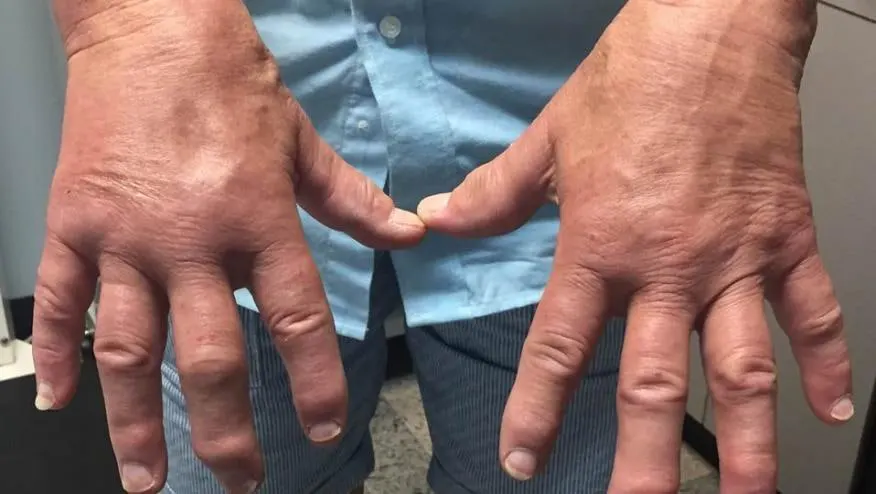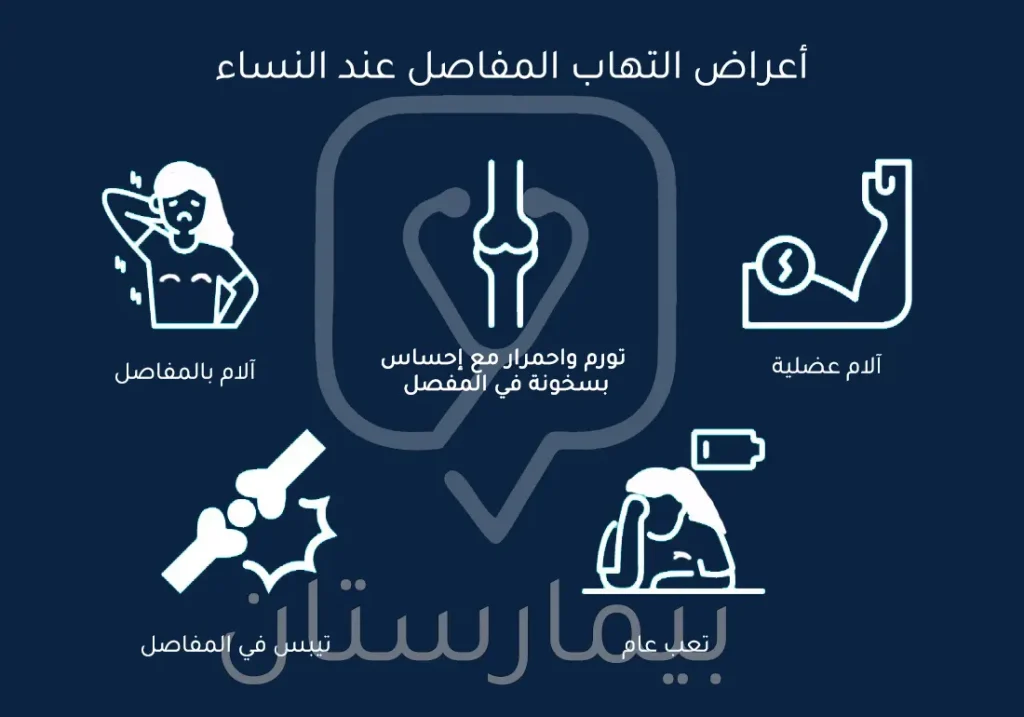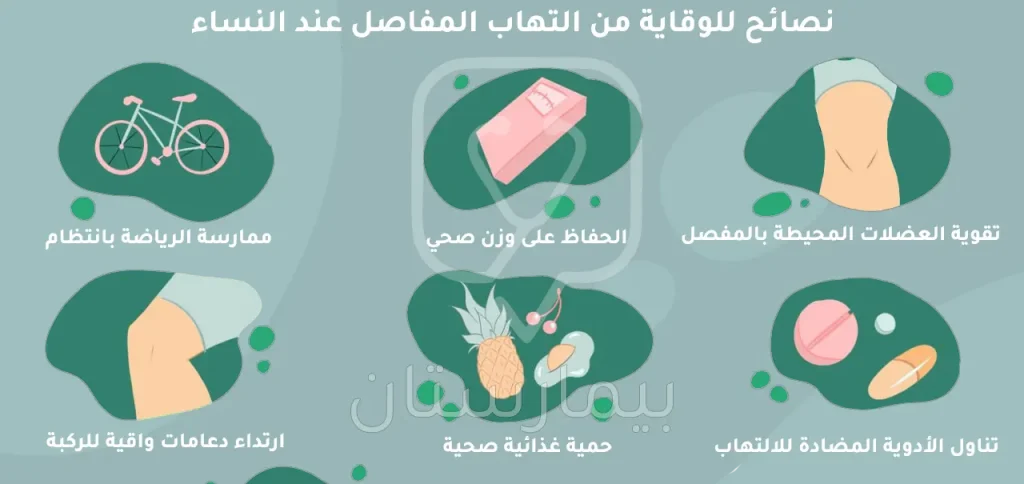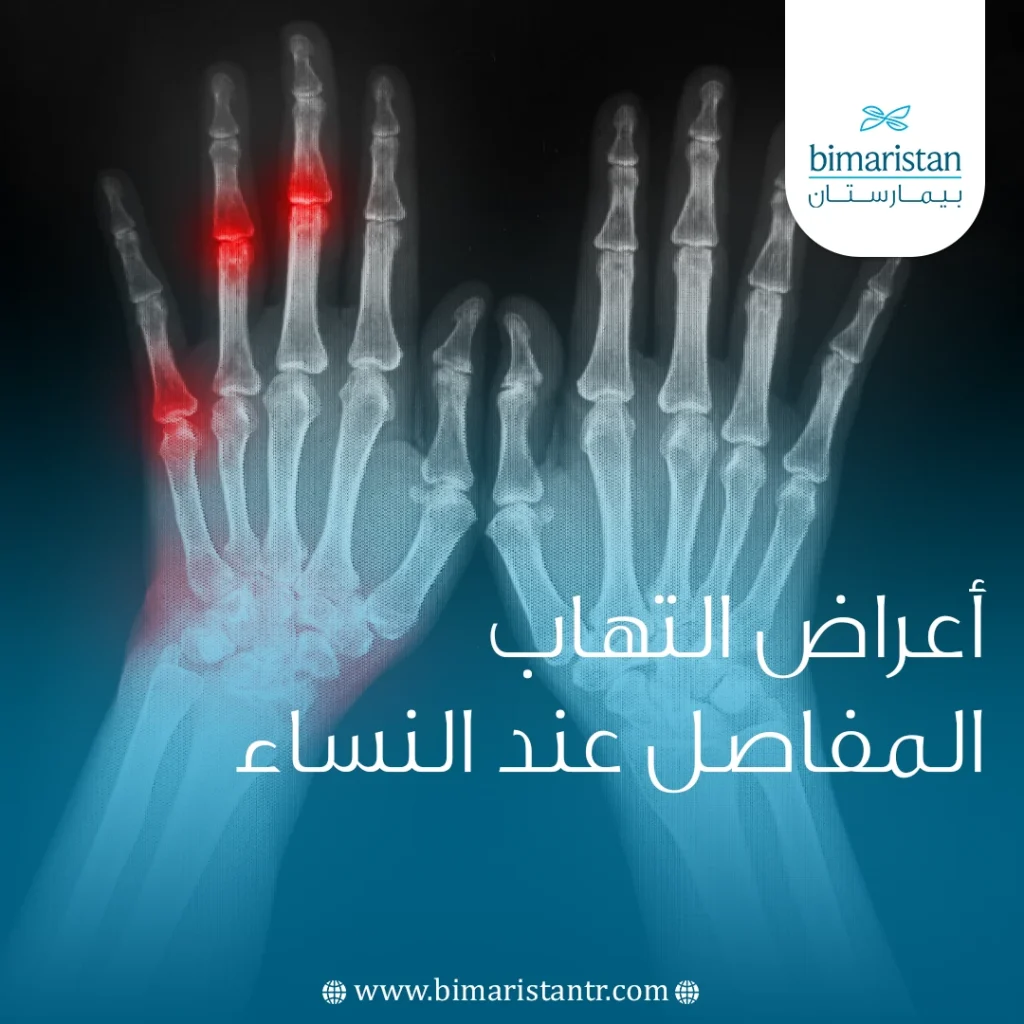عادة ما تكون أعراض التهاب المفاصل عند النساء أكثر حدة مما هو عليه عند الرجال، فعندما تصاب المرأة بالتهاب في المفصل قد تشعر بألم شديد يؤثر على جودة حياتها.
لا شك بأن آلام اليدين والقدمين من أشيع الأعراض التي تعاني منها النساء حول العالم، قد يكون سبب هذا الألم عائد لأمراض لا علاقة لها بالمفاصل كقصور الغدة الدرقية وغيرها من الأمراض الأخرى، لذا كان لا بد من التحري عن أعراض التهاب المفاصل عند النساء لمعرفة فيما إذا كان السبب مفصلي أم لا.
إن النوعين الأكثر شيوعاً لالتهاب المفاصل Arthritis هما الالتهاب الروماتويدي والفصال العظمي، وعلى الرغم من اختلاف سبب وآلية حدوثهم إلا أنهما يشتركان بأعراض متشابهة نوعاً ما، تابعي معنا لتتعرفِ على جميع اعراض التهاب المفاصل وكيفية علاجه.
أعراض التهاب المفاصل عند النساء
عادةً ما تظهر أعراض التهاب المفاصل عند النساء بعمر 30 إلى 50 سنة، ولكن ليس بالضرورة أن تصاب هذه الفئة العمرية فقط، فقد تشاهد الاعراض عند الأطفال المصابين بهذا المرض أيضًا.
غالباً ما تأتي الأعراض على فترات متقطعة فقد تختفي تارةً وتشتد تارة أخرى، وقد تلاحظ في أوقات محددة من اليوم كاليبوسة التي تحصل مباشرة بعد الاستيقاظ من النوم.
قد تختلف علامات التهاب المفاصل وأعراضه من امرأة لأخرى تبعاً لشدة الإصابة ونوع الالتهاب، لكن عند إصابتكِ بمرض التهاب المفاصل غالباً ما تلاحظين ظهور أحد هذه الأعراض:
ألم في المفاصل
يصيب الالتهاب مفاصل عدة من الجسم ويسبب آلام فيها وبشكل خاص القدمين واليدين إضافةً إلى الركبة والحوض، بالنسبة لصفات ألم المفاصل فهي متغيرة بحسب شدة الالتهاب، فقد يكون متقطعاً يأتي بشكل فترات وقد يصبح مستمراً ومزمن.
غالبًا ما يكون الألم هو العرض الأول الذي يشعر به مرضى التهاب المفاصل، يتصف بالبداية بأنه على شكل وجع خفيف مع إحساس حارق.
يكون ألم التهاب المفاصل أكثر وضوحاً في فترات الراحة وهذا ما يميزه عن الأسباب الميكانيكية أو الرضية لآلام المفصل والتي تزداد شدة بالحركة، لكن النشاط المجهد للمفصل كصعود الدرج قد يحرض ألم الالتهاب بعد فترة وجيزة إلا أن الألم لا يظهر عادة أثناء القيام بالنشاط.
التورم والاحمرار حول المفصل
كثيراً ما يترافق التهاب المفاصل مع تورم واحمرار مع إحساس بسخونة عند لمس المفصل، هذا العرض يشاهد بِشكل خاص عند النساء المصابات بالتهاب المفاصل الروماتويدي ويعود السبب في ذلك لكون الفعالية الالتهابية تؤدي إلى ازدياد تدفق الدم وتوسع الشعيرات الدموية في منطقة الالتهاب.
تعتمد درجة الاحمرار والتورم على فعالية التهاب المفاصل وشدته فكلما كان المرض أكثر نشاطاً كلما كان انتفاخ وتورم المفصل أوضح، أكثر ما يشاهد التورم حول مفصل الركبة، يمكنك القراءة أكثر عن أسباب تورم الركبة.

تيبس المفاصل
اليبوسة أو الصلابة هي من أكثر الأعراض الشائعة لمرض التهاب المفاصل عند النساء، وهي عبارة عن صعوبة ومحدودية في حركة المفصل، فعندما تشعرين بصعوبة في ثني أصابعك وتحريكها لفترة تقدر بـ 30 دقيقة بعد استيقاظك من النوم قد تكونين مصابة بالتهاب في المفاصل، قد تطول المدة اللازمة لزوال التيبس بحسب نوعية الالتهاب وشدته.
لا داعي للقلق إذا كنتِ تعانين من أعراض التهاب المفاصل فوفقاً لما أشارت إليه الأبحاث والدراسات الإحصائية فإن أكثر من ربع النساء في الولايات المتحدة الأمريكية مصابات بالمرض سواء كان من النوع الروماتويدي أو نوع آخر.

أعراض التهاب المفاصل عند النساء الحوامل
زيادة الوزن الطبيعي للنساء خلال فترة الحمل قد تسبب تزايد في شدة الأعراض بسبب اشتداد الضغط المطبق على المفصل، فمن الطبيعي للمرأة الحامل المصابة بالتهاب مفاصل روماتويدي أن تشتد آلام المفاصل لديها وتشعر بأن أعراض المرض أصبحت أكثر وضوحاً وخاصةً في مفصل الركبة.
يفضل على النساء اللواتي تعانين من التهاب مفاصل مشخص مسبقاً مراجعة الطبيب عند الحمل، وذلك لعمل تقييم ومراجعة الأدوية المأخوذة للعلاج فبعض الادوية يجب تغييرها عند الحامل خوفاً من تأثيراتها المشوهة على الجنين.
كما ذكرنا سابقاً فإن الشعور بتزايد الاعراض خلال الحمل أمر طبيعي ليس فقط للزيادة الطبيعية بالوزن بل للعوامل النفسية أيضاً والتقلبات المزاجية التي تتعرض لها الحوامل.
أسباب التهاب المفاصل عند النساء
النساء أكثر عرضة للإصابة بالتهاب المفاصل مقارنة مع الرجال سواءً كان الالتهاب من النمط الروماتويدي أو التنكسي (الفُصال العظمي)، ولا يقتصر الأمر على شيوع الإصابة فحسب إذ أن أعراض التهاب المفاصل عند النساء هي أشد وأكثر إزعاجاً من الرجال ويعتقد أن السبب في ذلك يعود لاجتماع بعض العوامل ومنها:
العامل المناعي لالتهاب المفاصل الروماتويدي
إن سبب التهاب المفاصل الروماتويدي هو خلل في الآلية المناعية بالجسم بمعنى أن مناعة الجسم لديكِ تقوم بمهاجمة النسيج الطبيعي في المفاصل مما يسبب رد فعل التهابي والذي يؤدي لظهور الأعراض الالتهابية.
بِشكل عام فإن النسوة هم أكثر عرضة للإصابة بالأمراض المناعية بنسبة تصل إلى 4 أضعاف نسبة الاصابة عند الرجال، تم وضع فرضيات عدة لتفسير هذه النتائج فالبعض عزى هذ الأمر لعوامل جينية بيولوجية والبعض الآخر أشار إلى دور الهرمونات الأنثوية في حدوث ذلك واقترح البعض مساهمة العوامل البيئة بينما لم يتم بعد إثبات أي من واحدة من هذه الفرضيات.
العوامل المسببة للفصال العظمي
كما هو الحال بالالتهاب الروماتويدي فإن النساء أكثر عرضة للإصابة بفصال العظام من الرجال وخاصة السيدات اللواتي تزيد أعمارهم عن 50 سنة ودخلن بفترة انقطاع الطمث.
إن أهم سبب لحدوث التهاب المفاصل التنكسي هو زيادة الوزن والسمنة نتيجةً لزيادة الحمل على المفصل والذي يقود مع مرور الوقت إلى إجهاده ليحدث بعدها تآكل وتنكس بأجزاء المفصل، يُضاف لما سبق تأثير التغيرات الهرمونية بعد بلوغ المرأة سن اليأس فانخفاض مستويات هرمون الإستروجين الأنثوي يساهم لحدٍ ما في ارتفاع خطر الإصابة بأمراض مفصلية وظهور أعراض التهاب المفاصل عند النساء.
كيفية علاج التهاب المفاصل عند النساء
يهدف العلاج بشكل رئيسي لتخفيف الأعراض وتحسين جودة الحياة حيث لا يوجد معالجة شافية نهائياً من التهاب المفاصل، لكن اتباع نظام علاجي جيد قد يمكن المريضة من السيطرة على أعراض الالتهاب والتخفيف من ألم مفاصلها لدرجة كبيرة.
تتوفر العديد من الطرق لتدبير التهاب المفاصل وعلاجه نذكر أهمها:
علاج التهاب المفاصل عند النساء بالأدوية
يختلف الدواء المناسب باختلاف نوعية الإلتهاب، ولكن عادة ما يتم استخدام واحد من هذه الأدوية وهي:
مضادات الالتهاب اللاستيروئيدية NSAIDS
تستعمل هذه المجموعة الدوائية لتسكين ألم المفاصل وتخفيف الالتهاب وهي تصرف دون الحاجة لوصفة طبية، من أشيع أدوية هذه المجموعة الإيبوبروفين والذي يعد من أكثر الأدوية استعمالاً كمسكن للألم مع الانتباه إلى بعض التأثيرات الجانبية المحتملة كتشكل القرحات الهضمية، اقرأ أكثر عن قرحة الاثنى عشر.
الستيروئيدات القشرية
تستخدم الستيروئيدات في علاج التهاب المفاصل الروماتويدي وهي تعمل عبر تثبيط مناعة الجسم مما يقلل من الاستجابة والأعراض الالتهابية لكنها قد تترافق مع آثار جانبية عند استخدامها بالشكل الخاطئ دون استشارة الطبيب.
علاج التهاب المفاصل عند النساء عبر حقن البلازما
تطور الطب الحديث في مجال علاج الأمراض المفصلية حيث ظهرت طريقة جديدة للعلاج عبر حقن بلازما بشرية مستخلصة من الدم في المفصل المصاب والتي أثبتت فعاليتها في علاج طيف واسع من أمراض المفاصل.
يمكنك القراءة أكثر عن حقن البلازما للركبة.
علاج التهاب المفاصل بالجراحة
في المراحل الشديدة من إلتهاب المفاصل التنكسي تصبح جراحة استبدال المفصل هي الخيار الأنسب في تخفيف ألم المرض وتحسين جودة حياة المريضة خاصةً بالتهاب الركبة لأن عملية تغيير مفصل الركبة واستبداله بمفصل صنعي أصبح من العمليات كثيرة الانتشار وسهلة الإجراء.
يمكن أيضًا اللجوء إلى العلاج الطبيعي وإعادة التأهيل لتحسين مجال الحركة واستعادة قوة المفصل.

الوقاية من أعراض التهاب المفاصل
إجراء تعديلات صحية على نمط الحياة قد يساعد بالوقاية والتخفيف من أعراض التهاب المفاصل بنوعيه الروماتويدي أو التنكسي.
إليكِ أهم التعليمات والنصائح لتخفيف الأعراض والوقاية منها:
- خسارة الوزن في حالة السمنة
- ممارسة التمارين الرياضية بانتظام والتي لا تتطلب حمل أوزان ثقيلة
- تجنب التدخين
- تطبيق كمادات ثلج أو وسائد دافئة على المنطقة الملتهبة
وبالنهاية فإن أعراض التهاب المفاصل عند النساء كثيرة الشيوع وقد يكون لها تأثير على حياة المريضات من خلال الآلام الشديدة والتيبس وغيرها من الأعراض الأخرى، لذلك فإن تشخيص الالتهاب يتم أولاً عبر تمييز العلامات والأعراض ومن ثم استشارة طبيبكِ الذي سيقوم بإجراء وطلب الفحوصات اللازمة للبدء بالمعالجة المبكرة.
المصادر:








